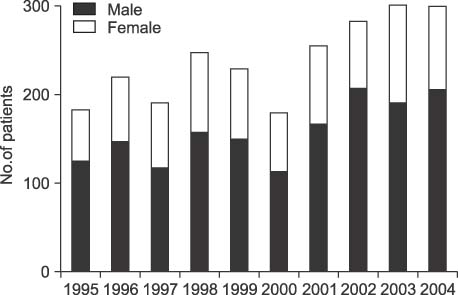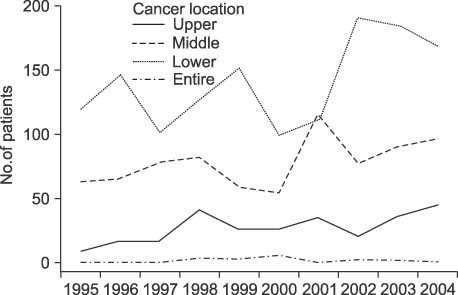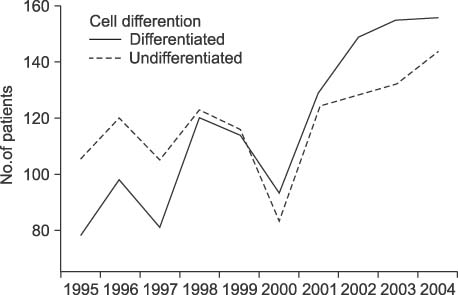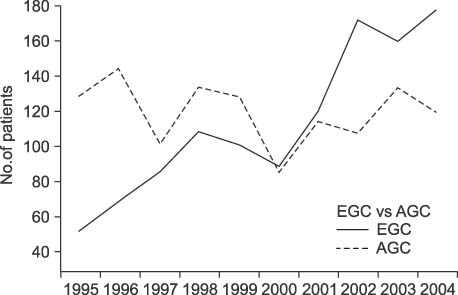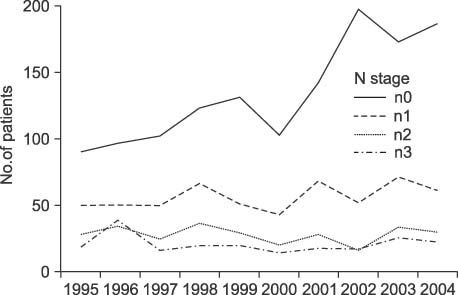J Korean Surg Soc.
2009 Aug;77(2):88-95. 10.4174/jkss.2009.77.2.88.
Annual Change of Clinicopathologic Characteristics after Radical Gastrectomy due to Gastric Cancer
- Affiliations
-
- 1Department of Surgery, Yeungnam University College of Medicine, Daegu, Korea. swkim@med.yu.ac.kr
- KMID: 2211287
- DOI: http://doi.org/10.4174/jkss.2009.77.2.88
Abstract
- PURPOSE
Recently, early gastric cancer has increased in Korea. Thus, endoscopic treatment and laparoscopic gastrectomy has increased in early gastric cancer patients. We studied periodic change and characteristics in gastric cancer patients. Thus, we analyzed annual change of clinicopathological characteristics and long-term survival results of gastric cancer patients after radical gastrectomy over 10 years. METHODS: From 1995 to 2004, 2,387 patients underwent radical gastrectomy due to gastric cancer. We analyzed annual characteristics, sex, age distribution, cancer location, depth of invasion, lymph node metastasis, UICC stage and 5-year survival rates, retrospectively from medical records. RESULTS: The number of gastric cancer patient has increased annually. The ratio of male to female was 2:1. Gastric cancer was most common and increased annually in the 60~79-year age group. Early gastric cancer increased annually. The 5-year survival rate was 93% in stage Ia, 89% in stage Ib, 72% in stage II, 51% in stage IIIA, 38% in stage IIIb and 22% in stage IV. Multivariate analysis revealed that UICC stage (or depth of invasion and lymph node metastasis) and cancer location were the main independent prognostic factors. CONCLUSION: Prognosis is improved due to increase of early gastric cancer. So, we should attempt diagnosis early and treat early gastric cancer. Active treatment is recommended even for the elderly gastric cancer patients. And care should be taken with respect to morbidity and mortality.
MeSH Terms
Figure
Cited by 2 articles
-
Characteristics of Gastric Cancer in Korea - with an Emphasis on the Increase of the Early Gastric Cancer (EGC)
Ki Joo Kang, Jun Haeng Lee
J Korean Med Assoc. 2010;53(4):283-289. doi: 10.5124/jkma.2010.53.4.283.Clinicopathological Features of Upper Third Gastric Cancer during a 21-Year Period (Single Center Analysis)
Je-Ho Jang, Reinaldo Isaacs Beron, Hye Seong Ahn, Seong-Ho Kong, Hyuk-Joon Lee, Woo-Ho Kim, Kuhn Uk Lee, Han-Kwang Yang
J Gastric Cancer. 2010;10(4):212-218. doi: 10.5230/jgc.2010.10.4.212.
Reference
-
1. Shin HR, Jung KW, Won YJ, Kong HJ, Yim SH, Sung J, et al. National cancer incidence for the year 2002 in Korea. Cancer Res Treat. 2007. 39:139–149.2. Ministry of Health and Welfare. Yearbook of Health and Welfare Statistics. 2007. Gwacheon, Korea: Ministry of Health and Welfare.3. Noh SH, Yoo CH, Kim YI, Kim CB, Min JS, Lee KS. Results after a gastrectomy of 2,603 patients with gastric cancer: analysis of survival rate and prognostic factor. J Korean Surg Soc. 1998. 55:206–213.4. Kim JP, Lee JH, Kim SJ, Yu HJ, Yang HK. Clinicopathologic characteristics and prognostic factors in 10,783 patients with gastric cancer. Gastric Cancer. 1998. 1:125–133.5. Park JI, Jin SH, Bang HY, Paik NS, Moon NM, Lee JI. Survival rates after operation for gastric cancer: fifteen-year experience at a Korea Cancer Center Hospital. J Korean Gastric Cancer Assoc. 2008. 8:9–19.6. Lee YA, Jung GA, Min YD. Operative treatment of patients over 75 years old with gastric cancer. J Korean Gastric Cancer Assoc. 2005. 5:217–221.7. Song RJ, Kim SP, Min YD. Clinicopathologic characteristics and the prognosis of gastric cancer patients at both extremes of age. J Korean Gastric Cancer Assoc. 2007. 7:67–73.8. Kang WS, Cheong O, Jeong MR, Kim HG, Ryu SY, Park YK, et al. Evaluation of the safety and feasibility of D2 lymphadenectomy in elderly patients with gastric cancer. J Korean Gastric Cancer Assoc. 2008. 8:85–90.9. Gretschel S, Estevez-Schwarz L, Hunerbein M, Schneider U, Schlag PM. Gastric cancer surgery in elderly patients. World J Surg. 2006. 30:1468–1474.10. Kim SH, Ahn SH, Park KC. General characteristics of gastric cancer of 3rd decade male patients. Korean J Gastroenterol. 1991. 4:857–865.11. Kim CH, Jang SW, Kang SH, Kim SW, Song SK. The significance of lymphatic, venous, and neural invasion as prognostic factors in patients with gastric cancer. J Korean Gastric Cancer Assoc. 2005. 5:113–119.12. Information Committee of the Korean Gastric Cancer Association. Current status of chemotherapy for gastric cancer patients in Korea - a nationwide survey. J Korean Surg Soc. 2005. 69:13–23.13. Bonenkamp JJ, Hermans J, Sasako M, van de Velde CJ, Welvaart K, Songun I, et al. Extended lymph-node dissection for gastric cancer. N Engl J Med. 1999. 340:908–914.14. Cuschieri A, Fayers P, Fielding J, Craven J, Bancewicz J, Joypaul V, et al. The Surgical Cooperative Group. Postoperative morbidity and mortality after D1 and D2 resections for gastric cancer: preliminary results of the MRC randomised controlled surgical trial. Lancet. 1996. 347:995–999.15. Diaz de Liano A, Yarnoz C, Aguilar R, Artieda C, Ortiz H. Rationale for gastrectomy with D2 lymphadenectomy in the treatment of gastric cancer. Gastric Cancer. 2008. 11:96–102.16. Candela G, Sergio V, Di Libero L, Manetta F, Giordano M, Lanza M, et al. Prognostic and therapeutic value of D2 lymphadenectomy in the treatment of gastric cancer: experience of an Italian team. Chir Ital. 2008. 60:675–684.17. Smith BR, Stabile BE. Aggressive D2 lymphadenectomy is required for accurate pathologic staging of gastric adenocarcinoma. Am Surg. 2006. 72:849–852.18. Blot WJ, Devesa SS, Kneller RW, Fraumeni JF Jr. Rising incidence of adenocarcinoma of the esophagus and gastric cardia. JAMA. 1991. 265:1287–1289.19. Ohno S, Tomisaki S, Oiwa H, Sakaguchi Y, Ichiyoshi Y, Maehara Y, et al. Clinicopathologic characteristics and outcome of adenocarcinoma of the human gastric cardia in comparison with carcinoma of other regions of the stomach. J Am Coll Surg. 1995. 180:577–582.20. Kajiyama Y, Tsurumaru M, Udagawa H, Tsutsumi K, Kinoshita Y, Ueno M, et al. Prognostic factors in adenocarcinoma of the gastric cardia: pathologic stage analysis and multivariate regression analysis. J Clin Oncol. 1997. 15:2015–2021.21. Ryu KW, Kim CS, Goo BH. Clinicopathologic characteristics of and prognosis for proximal gastric carcinomas. J Korean Surg Soc. 2000. 59:223–228.22. Yoon KY, Lee SH, Choi KH. Comparison between proximal gastric cancer and distal gastric cancer. Korean J Gastroenterol. 2002. 40:241–246.23. Kim DY, Joo JK, Ryu SY, Park YK, Kim YJ, Kim SK. Clinicopathological characteristics and prognosis of carcinoma of the gastric cardia. Dig Surg. 2006. 23:313–318.24. Fujiwara M, Kodera Y, Misawa K, Kinoshita M, Kinoshita T, Miura S, et al. Longterm outcomes of early-stage gastric carcinoma patients treated with laparoscopy-assisted surgery. J Am Coll Surg. 2008. 206:138–143.
- Full Text Links
- Actions
-
Cited
- CITED
-
- Close
- Share
- Similar articles
-
- Pancreatoduodenectomy with uncut-Roux-en-Y reconstruction in patients with previous radical gastrectomy
- Clinicopathologic Evaluation of Patients with Recurrence of Gastric Cancer within 6 Months after Curative Resection
- Clinicopathologic Analysis of Gastric Carcinoma Patients with Outlet Obstruction
- Clinicopathologic Characteristics of Gastric Cancer Patients according to the Timing of the Recurrence after Curative Surgery
- The Preservation of Left Gastric Atery in Laparoscopy-Assisted Subtotal Gastrectomy with Splenectomy of Stomach Cancer

